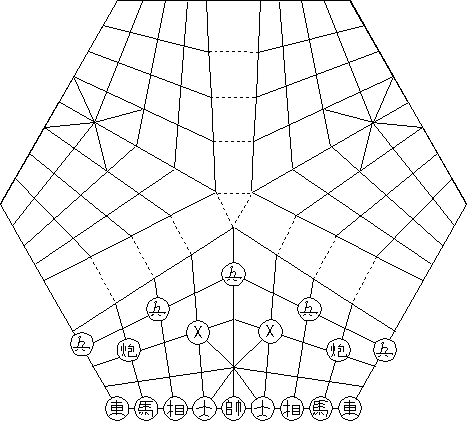

| More Information on this item |
|
Kriegspiel is September's Recognized Chess Variant of the month. |
Rate this page! | Skip to comments
According to H.R. Murray, this game is supposed to illustrate the war of the Three Kingdoms (although perhaps "The 3 Kingdoms" version, and not this one, is meant): Wei (blue), Shu (red) and Wu (green), A.D. 221-64. The lines of the board are not straight throughout, and each army faces the other two. The pieces consist of the regular 16, but also a different piece (2 of them for each army). This piece in red's army is designated as (F) for "fire." Blue's is called (B) for "banner" and green's is called (W) for "wind." Their move is an extended knight's move: 2 steps vertically or horizontally and then 1 step diagonally. In the initial position, they each sit 2 spaces directly above the guards of each army.
When one of the Generals (who are named Wei, Shu, and Wu) is mated, the player who has mated him removes the king from the board and adds the remainder of his army to his own.
A diagram of the board is given in H.R. Murray's book, A History of Chess. It is displayed below.

The piece marked X is the Fire, Banner or Wind piece. It is not displayed with its proper symbol, because this is not known to me (it was not given in Murray's History of Chess.) Clockwise around the board, we have the green, red, and blue army: each has the same opening setup (only the setup of one player is shown in the diagram above.) The pieces at the bottom row are, from left to right: Rook, Horse (or Knight), Elephant, Guard, King, Guard, Elephant, Horse (or Knight), Rook. At the third row, we find the extra pieces, and two cannons, while also five pawns are at the fourth row.
| Date | Name | Rating | Comment |
|---|---|---|---|
James Killian Spratt  | None | Hi, Sean. How about the human politics during play? Do two weak players gang up on the strongest? I've found that typical in Chess for Three. | |
Sean Humby  | Excellent | I have to say after playing this game, I've gotten a great appreciation for it. This is the best balanced 3 player chess variant I've ever played. (And I've tried a few... mostly garbage...) Please note that as in regular 2player Xiangqi the Generals may 'throw their spears'. Now, when they are in the middle position they are actually able to check both other generals at once! The middle ground is prime real estate and generally quite difficult to hold for any prolonged time. The only really difficult task is creating the board itself. It took me a few minutes to figure out how to make a regular hexagon from scratch. ;D I HIGHLY recommend this game. | |
Charles Gilman  | Excellent | Presumably movement between 2 of the central 5-way junctions can only count as an orthogonal move and not a diagonal one, as there is no change of file. The extra piece could be uniformly called a Camel in European/American usage, as it is a Chinese-style version of the piece generally called a Camel | |
 | Excellent | hmm awwwesome.. never seen this before... could be very interesting.. wonder if there are copetitions to make this game more widely known.. would be interesting to have the whole world know of this game.. | |
Sean  | Excellent | I would love to know how the WIND piece works. |
This item has a total of 7 comment(s), 5 rating(s), and an average rating of Excellent. View all comments for this item.
Provide feedback on this page!


Last modified: Sunday, August 21, 2005